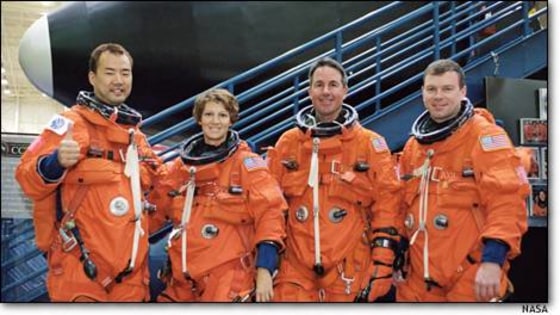NASA is settling on a plan for the space shuttle’s “return to flight” next year, internal documents obtained by MSNBC.com show. These plans include moving the launch date for the flight, called STS-114, from the unrealistic “no earlier than March 11” into July 2004 or later. They also involve a major overhaul in the mission objectives and the addition of an extra shuttle mission two months later, to precede an ambitious rapid-fire sequence of space station expansion flights now planned for 2005.
Three of the original seven members of the first shuttle flight have been removed, since the originally planned station crew rotation has been canceled. This makes room for new astronauts with specialized skills needed for the flight’s new responsibilities. “It takes at least six [astronauts] to do all the things we want to do safely,” shuttle program director William Parsons told reporters in Houston last week.
The core crew remains unchanged, commanded by veteran astronaut Eileen Collins. With her is veteran pilot Jim Kelly, veteran spacewalker Steve Robinson, and rookie Japanese astronaut Soichi Noguchi.
Some of the new astronauts who will join them will assist during spacewalk tests of tile inspection and repair techniques, with the replacement of a critical stabilization device, and with the urgent restocking of the International Space Station. “The astronaut office is thinking of the needed skill mix and who to put on the crew,” said Paul Hill, the NASA flight director in charge of the Mission Control team.
One of the crewmembers may also remain aboard the space station, bringing the total crew complement of the resupplied station to three. The opportunity also exists — so far in only low-level discussions — to include a nonprofessional crewmember who would symbolize NASA’s commitment to flight safety. Various suggestions, ranging from NASA Administrator Sean O’Keefe himself, to a member of the Gehman Commission that recently issued its final accident report, have been heard, but the informal proposal has not reached a serious level.
The official mission planning document, obtained exclusively by MSNBC.com, calls for the official launch date of the “Atlantis” to be moved to July 15, 2004, at the earliest. The March date, announced only a few weeks ago, “can no longer be supported”, this document states, and the change “will prevent wasted work.” The mission retains its station codename of “ULF1”, for “Utilization and Logistics Flight #1.”
The new mission to be inserted will be called “ULF1.1,” indicating an additional mission contributing to the goals of the original mission. This flight is called STS-121 because the half dozen numbers subsequent to “114” have already been assigned to follow-on missions that already have published extensive documentation with their specific numbers. “121” was the first available number after this group.
The mission will be flown by the shuttle Discovery no earlier than Sept. 16, 2004, two months after STS-114. Like the first mission, STS-121 will carry an Italian-built logistics module loaded with supplies and equipment. It will also carry a three-person space station crew to relieve the team aboard the International Space Station.
The new mission also allows miscellaneous station resupply and add-on tasks stuffed into available corners of STS-115, 116, and 117 to be off-loaded from those flights and accomplished by STS-121. Shuttle program manager Parsons called those flights a “difficult sequence” that would be made easier with the insertion of the extra mission. “It is a very serious sequence, and all of it has to go like clockwork,” Hill said.
Parsons also described plans to test tile repair tools on the first shuttle mission, then return the samples to Earth for thermal and mechanical testing that would verify the effectiveness of the techniques. The extra mission, which includes two new space walks, would provide an opportunity to retry any tools that had not functioned as hoped.
Crew reshuffle
The option to leave one of the STS-114 crewmen aboard the station when the shuttle returns to Earth remains under discussion, NASA officials have said. “We MAY augment, go from two to three on the station,” space station program director William Gerstenmeier said last week. But it remains only an option under discussion, he added.
If the first shuttle mission occurs between April and October of next year, the two men they will meet aboard the station at that time will be astronaut Bill McArthur and cosmonaut Valeri Tokarev. This pair would either be replaced by a three-person crew brought up on STS-121 in September, or by a separate two-person crew launched on the regularly-scheduled Soyuz replacement mission in October 2004.
To simplify training and preserve the option of augmenting or not, depending on schedules, the candidate astronaut probably will be a recently-trained space station veteran, such as Peggy Whitson, Don Pettit or Don Thomas, originally a member of a 2002 crew but replaced by Pettit.
A four-person core crew for the new STS-121 missions needs to be assigned shortly. A half dozen veteran commanders and pilots are available, along with mission specialist astronauts already deeply involved with development of the tile repair tool kit. The sentimental favorite among them has to be Anna Fisher, a member of the original shuttle class of 1978 who flew in 1984 and then took an extended leave of absence before returning to flight status three years ago. She helped spearhead the original tile repair tests back in 1980 and is now back on the same project.
James Halsell, the astronaut who is coordinating the return-to-flight activity, discussed the idea of a “symbolic crewman” for STS-114 with MSNBC.com. “I sometimes think they picked me for this job because I’m scheduled to command a downstream mission so I’m motivated to get it right,” he said. Referring to the suggestion to send O’Keefe up on the mission, he joked, “It would work times ten if we sent him.”
